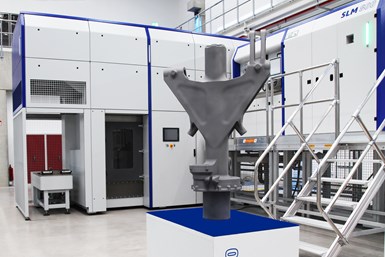Tall AM Build Envelope Cuts Months of Aerospace Prototyping
By using SLM Solutions’ vertically extended SLM 800 3D printer, Safran was able to develop and produce a large component for landing gear on a small business jet in days instead of months.
Share






Turning to additive manufacturing enabled Safran Landing Systems to produce a fitting in a few days as opposed to several months. Photo Credit: SLM Solutions
In a joint project, and SLM Solutions used selective laser melting to produce a component for the nose landing gear of a small business jet.
The companies meant to demonstrate the feasibility of selective laser melting for a main fitting, in what would be an uncommonly large build for the AM process. They redesigned the component for metal additive manufacturing, saving time throughout the process and reducing component weight by about 15%. Final part dimensions came in at 455 × 295 × 805 mm. The final design is unique to Safran and is patented.
The component is one of the parts that transfers load from the wheel to the aircraft structure, and which is retracted after takeoff. Its importance results in stringent requirements, which Safran met through using titanium alloy. Titanium alloy was an ideal choice for the application because of the mechanical properties associated with the material, even when processed for AM. The alloy is naturally resistant to corrosion, increases part durability in relation to previous designs and does not require any surface treatment.
The initial challenge in developing the project was to find the right machine to produce the part because it is over 800 mm tall. “We chose SLM Solutions as a partner because of their expertise and the SLM 800 machine, which meets our requirements in terms of machine size and reliability,” says Thierry Berenger, additive manufacturing project leader at Safran Landing Systems.
The SLM 800’s build envelope of 500 x 280 x 850 mm enables the production of large components for industrial applications. It comes equipped with SLM Solutions’ quad-laser technology as well as reliability-increasing features like the patented gas flow and a permanent filter.
The flexibility of the SLM technology enabled rapid production of modified part designs, saving the companies time that would have otherwise been spend in prototype development.
“Additive manufacturing saves time in the qualification and certification phases by rapidly providing the parts for testing,” says Gerhard Bierleutgeb, executive vice president of Global Services and Solutions at SLM Solutions. “We were able to produce the main fitting in few days on the SLM 800, versus few months with the forging process.”
Related Content
-
Push-Button DED System Aims for Machine Shop Workflow in Metal Additive Manufacturing
Meltio M600 metal 3D printer employs probing, quick-change workholding and wire material stock to permit production in coordination with CNC machines.
-
Digitalization and Done-In-One Reign Supreme at BIEMH 2024
European manufacturers may have a different balance of markets than their U.S. counterparts, but the practical challenges they must overcome are often similar — as are the solutions.
-
Digital Transparency in Machining Key to Multi-Site Additive Manufacturing
Cumberland Additive’s CNC programmer in Pennsylvania spends most of his time writing programs for machine tools in Texas.

















